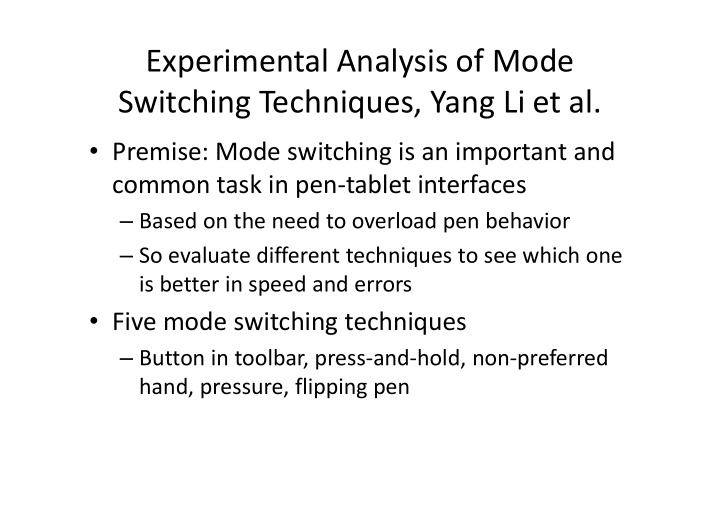



Experimental Analysis of Mode Switching Techniques, Yang Li et al. • Premise: Mode switching is an important and common task in pen-tablet interfaces – Based on the need to overload pen behavior – So evaluate different techniques to see which one is better in speed and errors • Five mode switching techniques – Button in toolbar, press-and-hold, non-preferred hand, pressure, flipping pen
Methodology • First a pilot – Tests pressure levels • Experimental task To capture the nature of sketch-based interactions, which – Pie cutting task are normally informal and fluid, we designed a pie-crossing task as an abstraction of the action of gesturing and inking • Baseline and (see Figure 2). A pie slice is shown with one of eight orientations corresponding to the eight major geographical compound (control directions. A participant was required to quickly cross a slice from its inner edge towards its outer edge according to and experimental) a target’s orientation. This design examines the drawing of various directions without requiring precise positioning and careful alignment by participants. This design also captures a realistic use scenario of gestures, i.e., marking menus [8], where users can cross a series of objects with marks to perform different commands.
Task • Pie cutting Control Experimental
Errors • One set of measures is accuracy of mode switching • What are errors? • Mode errors – Mode-in and Mode-out • Crossing errors • Out of target errors
Procedure • Training phase + test The experiment included a training phase for the baseline tasks, five experimental sessions with one session for each phase technique, and a post-study questionnaire. The experiment took about 80 minutes in total. A 5x5 Latin Square was – In this case training data used to counterbalance the order of the techniques. Each session was divided into two parts. The first part involved ignored learning to use a mode switching technique and extensive • 5X5 Latin square counter- practice. The second part was the experimental phase in which a participant was given 9 blocks of trials. The first balanced techniques block was a baseline task and then a compound task , alternating until the ninth block ended with a baseline task . • 9 Blocks A participant could take a break between blocks. In total, the experiment consisted of: – First baseline/control, 15 participants x 5 mode switching techniques x then experimental, 9 block of trials x 8 screens (8 orientations) x alternating for 5 control, 5 pie-crossing tasks 4 experimental = 27,000 pie-crossing tasks
Counter-balanced: Latin Square Design
Measures The dependent variables were the mode switching time , the • Dependent variables are time, total number of errors in a compound task, and the subjective preference of participants. The first two blocks errors, preference in the experimental phase were for warming up and the data • In 9 experimental blocks of the seven following blocks were used for analysis. The timing for each screen is started when the Start button – Two used as warm up, seven is clicked and automatically ended when the last pie is analysed crossed and the pen is lifted. This duration is divided into • Duration divided into 3 cycles three cycles. The first cycle starts when the Start button is clicked and ends when the first pie is crossed. The second – Break after first, third, last pie cycle starts right after the first cycle and ends after the third – Last two cycles have a mode- pie is crossed. This is followed by the third cycle, which switch includes crossing the last two slices. Therefore, one target needs to be crossed in the first cycle and two targets need to • Mode switch time = average be crossed in each of the second and the third cycles. We cycle duration for last two call cycle 2 and 3 full cycles and cycle one the start cycle . cycles with mode-switch in In a compound task , a full cycle contains a complete mode switch process including switching into gesture mode and compound – average cycle switching back to ink mode. duration for last two cycles in The mode switching time for each of the three compound control (see slide 4) blocks was computed by subtracting the mean of the two adjacent baseline tasks’ average cycle durations from the compound block’s average cycle duration . Average cycle duration was the mean duration of all correct full cycles in a block.
Task • Pie cutting Control Experimental
Results
Opinions • Most common goods: • Most common bads: – Thorough strategy to – University students capture interaction cycle – Ecological validity and cost – Number of participants – Good figures to describe • Others techniques, good study – Male-female ratio description. • Other good points – Criteria for five techniques – Preference (vs something – Good use of training like NASA TLX?) sessions – Good options for mode switching – Elicitation of preference
Bads: • University students – Performance, errors, and age • Ecological validity – Remember questions: • Is there a difference • Is the difference large or small • Is the difference statistically significant • Does the difference matter • Number of participants – How many would be good? – See http://daniellakens.blogspot.com/2016/11/why-within-subject-designs- require-less.html – https://statisticsbyjim.com/basics/central-limit-theorem/ – Normal corrections (Log-normal transforms, Box-Cox transform, aligned rank transforms) • http://faculty.washington.edu/wobbrock/pubs/chi-11.06.pdf
Recommend
More recommend